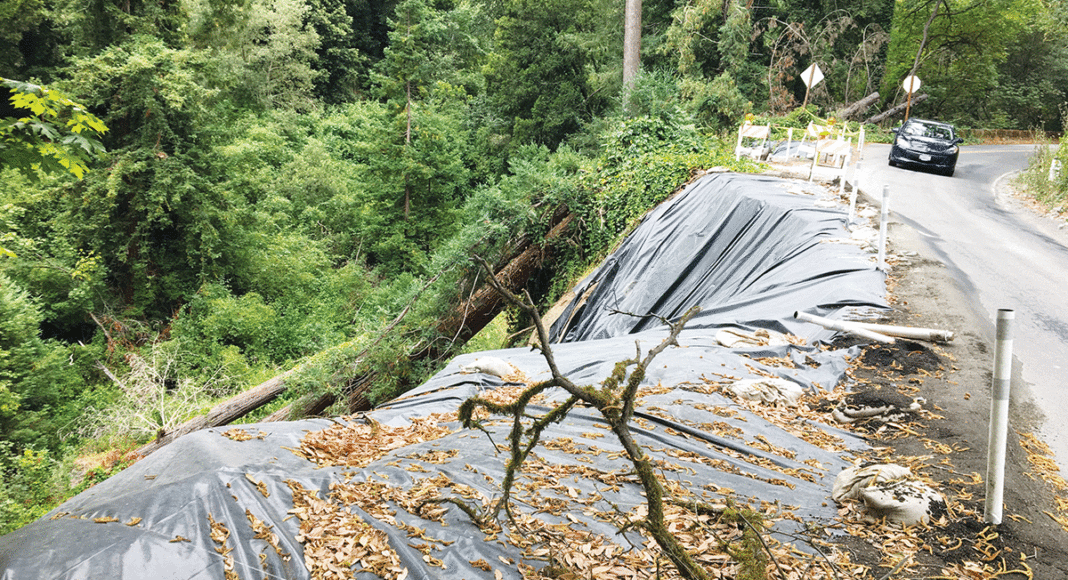One overcast Wednesday, Baylee Whitted is driving the streets surrounding her Aptos Hills home, showing me a ringside view of rutted, potholed roads in stretches chewed to pieces by winter storms.
It’s late July, still a few weeks before her kids’ classes start Valencia Elementary and Aptos Middle schools, and months before the next winter rains will begin.
But Whitted is already dreading taking her kids to school once the sky does let loose.
She’s abandoned her favorite scenic route on Cox Road for Day Valley Road to avoid four washouts, where the road is barely passable by one car. Whitted said that she has had several near misses with drivers not used to the treacherous roads.
Residents have been waiting for years for the county to repair existing storm damage—let alone potholes and cracks—and have repeatedly petitioned Santa Cruz County officials to get going.
The response, so far, has been lackluster, Whitted says.
“They have an answer for it, but it’s not what anyone wants to hear,” she says. “It’s, ‘We’re waiting on this,’ or, ‘We’re waiting on that.’”
Long-term fixes to many of the county’s transportation woes are covered by local and state funding, notably Measure D and Senate Bill 1, the state’s gas tax law. Storm repairs, however, are largely dependent on federal funding, says county spokesperson Jason Hoppin.
With $120 million in outstanding storm damage, Hoppin says gas tax revenue amounts to a drop in that bucket. So, although engineers are using new tax money to improve the county’s infrastructure, rural roads haven’t recovered from storms that struck more than two years ago.
“Working with the federal government has been a challenge on the federally funded repairs,” he says. “At a certain level, we have to wait for their approval and their review.”
GRADED ON A CURVE
The county’s roads—and those in jurisdictions throughout California—are graded on a scale of 1 to 100 with the Pavement Condition Index (PCI), a biennial report by Save California Streets.
The report looks at all aspects of road conditions, such as age, potholes and cracking.
For the latest iteration, released in October, unincorporated Santa Cruz County scored a 48 on the PCI scale, a solid “F” that places the roads in the “at risk” category, although it’s an improvement from years past.
The poor ranking comes largely from 20 years of deferred maintenance, and from lingering damage from 2017 winter storms. Almost two years later, there are still more than 100 projects to complete, says County Public Works Director Matt Machado.
The report also shows that the county’s 1,764 miles of roadways have a $453 million backlog of repairs needed to bring them up to snuff.
County residents got a glimmer of hope in 2016, when voters approved Measure D, a 30-year half-cent sales tax, which since its inception has raised some $63.8 million countywide for a large variety of transportation infrastructure projects.
The Santa Cruz County Regional Transportation Commission (RTC), which oversees allocation of Measure D funds, approved a five-year spending plan in June.
At the state level, officials say the new gas tax will raise roughly $54 billion over the next decade, which is split down the middle between state projects and regional transit agencies.
Under the law, Californians saw their per-gallon gas tax increase by 5.6 cents on July 1, making local gas among the most expensive in the nation.
Machado says that the county has dedicated its share of S.B. 1 funds, about $4 million per year, to repair the storm damage.
Measure D, meanwhile, is helping the county play catch-up on the needed repairs, he says, providing roughly $2.8 million annually for the past two years.
“Measure D has nearly tripled our investment in county roads, which is a very good thing,” he says.
Second District Santa Cruz County Supervisor Zach Friend calls gas and sales tax increases from Measure D “lifelines,” providing a much-needed shot in the arm for transportation, but he stresses that they’re far from being a panacea.
“The challenge for our county is the need is so large, with construction costs escalating daily and conditions deteriorating, that these lifelines will only be able to address a fraction of the growing need,” says Friend, who represents Aptos. “Without them, we would have no stable funding for any sort of work. Even with them, we will struggle to meet the significant, growing needs of our county’s roads.”
TALE OF THE CITIES
In South County, Watsonville Public Works Director Steve Palmisano says the roads are in “OK condition.” The city of 54,000 received a road condition score of 53 out of 100. He says that Measure D and S.B. 1 have tripled the amount that Watsonville receives for road maintenance.
The city has received about $1.6 million since the 2017-18 fiscal year. The sales tax is funding five major Watsonville projects between now and 2022, the first and biggest being Freedom Boulevard from Alta Vista to Green Valley Road, for which Measure D is kicking in $445,000 toward a $3 million bill.
A little farther north, Capitola Public Works Director Steve Jessberg says the arterial roads in his mid-county town rated a 78 on the PCI index, while the smaller residential streets received a 55 rating.
Measure D and S.B. 1, he says, provide an annual income of $300,000 and $165,000, respectively, which together are the city’s only revenue for road and sidewalk repair.
But those funds don’t cover the $750,000 needed to maintain Capitola’s streets from storm damage, Jessberg says, leaving city officials to pull from the city’s general fund and seek grants.
Still, the state and local funding has been essential for keeping the city in good repair, he says.
“They are both huge,” says Jessberg, who adds that 10 years ago Capitola had $50,000 set aside for road upkeep. “They are our dedicated funds for road improvement.”
Among future improvements will be a citywide repaving next year, with a focus on 41st Avenue.
The city of Santa Cruz has an even better outlook, thanks to extra funds. With a PCI of 69, the city of Santa Cruz boasts some of the best roads in the county. Assistant Public Works Director Chris Schneiter gives credit to a previous measure, approved by Santa Cruz voters in 2006.
“That’s been a consistent source of funds,” Schneiter says.
Measure D has pumped an additional $1.2 million into its transportation coffers for each of the past two years. And with about $1 million from S.B. 1, the city has doubled the amount of cash it puts into paving.
The city of Santa Cruz spent $2.7 million reconditioning Cedar Street, and will soon open bids to repair Water Street and River Street.
In Scotts Valley, Public Works Director Daryl Jordan says that the Santa Cruz Mountains city is combining last year’s Measure D funds with this year’s to pay for several street improvement projects.
The city receives $270,000 annually in Measure D funds, and about $215,000 annually from S.B. 1.
Scotts Valley is now opening bids for an ambitious series of road overlay, surfacing and sealing projects, including for Granite Creek Road and Scotts Valley Road. Jordan estimates that Measure D and SB 1 combined have boosted the city’s roads funds by 80%.
HIGHWAY PATROL
The county’s highway corridors are taking 25% of Measure D funds, with $14.1 million this year dedicated to upgrades and improvements.
The measure provided more than $694,000 for the Highway 9 corridor since 2016, and is pitching in funding for a variety of Highway 1 improvements, including a pedestrian/bicycle overcrossing at Mar Vista Drive.
Measure D promised its biggest slice to local roads. But for Whitted in the Aptos Hills, and for many other rural residents, 2016 campaign promises bring cold comfort.
“The piece where it’s supposed to go to repair our roads—we don’t see it,” she says. “I don’t see where that money is being used.”













